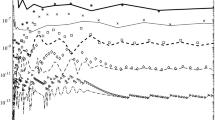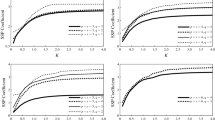Abstract
The standard algebraic stability condition for general linear methods (GLMs) is considered in a modified form, and connected to a branch of Control Theory concerned with the discrete algebraic Riccati equation (DARE). The DARE theory shows that, for an algebraically stable method, there is a minimal G-matrix, G *, satisfying an equation, rather than an inequality. This result, and another alternative reformulation of algebraic stability, are applied to construct new GLMs with 2 steps and 2 stages, one of which has order p=4 and stage order q=3. The construction process is simplified by method-equivalence, and Butcher’s simplified order conditions for the case p≤q+1.
Similar content being viewed by others
References
Albert, A.: Conditions for positive and non-negative definiteness in terms of pseudoinverses. SIAM J. Appl. Math. 17, 434–440 (1969)
Burrage, K.: High order algebraically stable multistep Runge-Kutta methods. SIAM J. Numer. Anal. 24, 106–115 (1987)
Burrage, K., Butcher, J.C.: Non-linear stability of a general class of differential equation methods. BIT 20, 185–203 (1980)
Butcher, J.C.: The order of numerical methods for ordinary differential equations. Math. Comput. 27, 793–806 (1973)
Butcher, J.C.: The equivalence of algebraic stability and AN-stability. BIT 27, 510–533 (1987)
Butcher, J.C.: Diagonally-implicit multi-stage integration methods. Appl. Numer. Math. 11, 347–363 (1993)
Butcher, J.C.: General linear methods. Acta Numer. 15, 157–256 (2006)
Butcher, J.C., Hill, A.T.: Linear multistep methods as irreducible general linear methods. BIT 46, 5–19 (2006)
Butcher, J.C., Jackiewicz, Z.: Diagonally implicit general linear methods for ordinary differential equations. BIT 33, 452–472 (1993)
Butcher, J.C., Jackiewicz, Z.: Construction of diagonally implicit general linear methods for ordinary differential equations. Appl. Numer. Math. 21, 385–415 (1996)
Dekker, K.: Algebraic stability of general linear methods. Technical Report No. 25, Computer Science Department, University of Auckland, New Zealand (1981)
Guo, C.-H.: Newton’s method for the discrete algebraic Riccati equations when the closed-loop matrix has an eigenvalue on the unit circle. SIAM J. Matrix Anal. Appl. 20, 279–294 (1998)
Hairer, E., Lubich, C., Wanner, G.: Geometric Numerical Integration. Springer, Berlin (2002)
Hill, A.T.: Nonlinear stability of general linear methods. Numer. Math. 103, 611–629 (2006)
Lancaster, P., Rodman, L.: Algebraic Riccati Equations. Oxford University Press, London (1995)
Author information
Authors and Affiliations
Corresponding author
Additional information
Communicated by S. Nørsett.
Rights and permissions
About this article
Cite this article
Hewitt, L.L., Hill, A.T. Algebraically stable general linear methods and the G-matrix. Bit Numer Math 49, 93–111 (2009). https://doi.org/10.1007/s10543-008-0207-7
Received:
Accepted:
Published:
Issue Date:
DOI: https://doi.org/10.1007/s10543-008-0207-7




